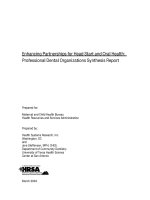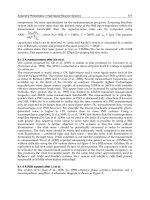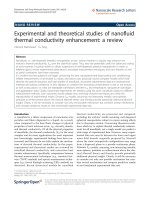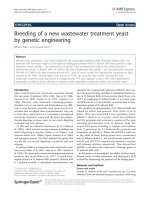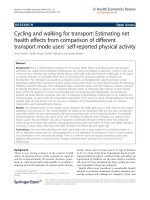Eidt-Koch and Greiner Health Economics Review 2011, 1:7 ppt
Bạn đang xem bản rút gọn của tài liệu. Xem và tải ngay bản đầy đủ của tài liệu tại đây (889.93 KB, 7 trang )
RESEARC H Open Access
Quality of life results of balloon kyphoplasty
versus non surgical management for osteoporotic
vertebral fractures in Germany
Daniela Eidt-Koch
1*
and Wolfgang Greiner
2
Abstract
Background: To compare improvement in quality of life (QoL) and symptoms’ relief in vertebral compression
fractures (VCF) due to osteoporosis for patients undergoing balloon kyphoplasty (BKP) to those undergoing non-
surgical management (NSM) in a real-life setting.
Methods: In this prospective, comparative study, quality-of-life was evaluated in eight centres in Germany between
2005 and 2008, for 82 patients, with the EQ-5D questionnaire, and the Roland Morris Disability Questionnaire
(RMDQ).
Results: BKP patients demonstrated a statistical and clinical significant higher improvement in EQ-5D than NSM
patients, 0.44 and 0.25 from baseline to 12 months, respectively. Moreover, BKP patients showed a clinically
relevant improvement in the RMDQ by 6.25 from baseline to 12 months, whereas NSM patients had no significant
improvement in the RMDQ.
Conclusions: This study demonstrates for VCF patients that in real-life quality of life for BKP patients improves
more than for NSM patients; confirming the results of a large randomized clinical trial.
Keywords: osteoporosis, vertebral compression fracture, quality of life, balloon kyphoplasty, Germany
Background
The social burden of osteoporosis has been increasing
during the last decades worldwide due to aging of popu-
lations and p otentially to changes in life st yle. The
WHO has ranked osteoporosis among the ten most
important diseases: “Osteoporosis has been recognized
as an established and well-defined disease that affects
more than 75 million people in the United States, Eur-
ope and Japan. It causes more than 8.9 million fractur es
annually worldwide, of which more than 4.5 million
occur in the Americas and Europe” [1]. Osteoporosis is
characterized by reduced bone mineral density which
leads to destruction of bone microstructure. A t early
stage, there a re no specific symptoms. In advanced
stages, increased risk of bone fractures in the spine, hips
or arms can be observed during daily routine activities
[2-4]. Vertebral compression fractures (VCF) due to
osteoporosis have been demonstrated to he avily impact
patients’ survival. In t he US, Medicare patients with a
VCF had an overall mortality rate twice higher than
patients without it after adjusting for co-morbidities,
with the greatest mortality rate in younger patients [5].
Two types of disease man agement are available to
treat VCF. The usual treatment is non-surgical manage-
ment (NSM). In this treatment option, analgesics can be
used to relieve pain as well as bed rest, physiotherapy
and/or back bracing in order to stabilize t he vertebral
fracture. NSM often leads to long hospital stays, slow
pain decrease, and sometimes persistence of pain. Addi-
tionally, brace often limits patients’ mobility, reduces
strength in back muscles and doesn’t revert kyphotic
deformity. Therefore, even though NSM can decrease
pain symptoms, it doesn’t solve vertebral body height
loss, kyphosis and reduced pulmonary function.
Other treatment options exist to better relieve pain
symptoms and restore spine curvature. Among those
* Correspondence:
1
Faculty of Public Health Services, Ostfalia - University of Applied Services,
Wolfsburg, Germany
Full list of author information is available at the end of the article
Eidt-Koch and Greiner Health Economics Review 2011, 1:7
/>© 2011 Eidt-Koch and Greiner; licensee Springer. This is an Open Acc ess article distributed under the terms of the Creative Commons
Attribution License (http://c reativecommons.org/licenses/by/2.0), which permits unrestricted use, distr ibution, an d reproduction in
any medium, provided the original work is properly cited.
treatments, balloon kyphoplasty (BKP) is a percutaneous
vertebral augmentation procedure for the treatment of
painful, acute vertebral fractures, designed to restore
vertebral body height and shown to reduce kyphosis, in
addition to relieve pain immediately. Due to height
restoration and stabilization of the vertebral body an
instantaneous pain relief can occur [6]. BKP has already
been shown to improve quality-of-life, function, mobility
and pain over NSM and more rapidly in VCF in a pro-
spective randomized clinical trial over 12 months [7].
This analysis aims at comparing improvement in QoL
in VCF patients due to BKP versus NSM in a real-life
health care setting. Even though prospective controlled
studies have been a lready published on BKP [8,9], this
prospective multicentre study done in German real-life
hospital settings is the first one collecting both QoL
measures and treatment costs over 12 months. More-
over, the QoL measures used in this study are directly
comparable with the ones used in the FREE randomized
clinical trial of BKP [7], thus making it possible to
address transferability of the RCT results to real-life.
This publication report res ults on QoL, whereas results
on costs will be reported in a subsequent article.
Methods
Treatment
Balloon kyphoplast y is a minimally invasive proced ure of
vertebral augmentation for the treatment of painful,
acute VCF. Through a small incision in the patient’s
back, the surgeon creates a small pathway to the frac-
tured bone with a hand drill. Through these channels,
inflatable bone tamps can then be inserted into the
medullary space and filled with a radiopaque contrast
medium for visualization. The balloon is carefully inflated
in order to restore the height and kyphotic angle of the
collapsed vertebra; and thereafter; it is deflated and
removed. The cavity created is filled i n with cement at
low pressure (typically polymethylmethacrylate) in order
to support the surrounding bone, prevent further col-
laps e and hold the restored vertebra in place. The proce-
dure is done on both sides of the vertebral body and can
be controlled by a digital meter for compre ssion. Thanks
to shape restoration and stabilization of the vertebral
body an immediate pain relief can occur [6].
Study design
Information on patients was collected during a multicen-
ter, prospective, controlled, non-randomized study. From
2005 to 2008, 124 osteoporotic patients with VCF were
treated in eight different study hospital centres and clinics
in Germany with NSM or BKP. They were then followed
over 12 months after intervention. Inclusion criteria were
the following: Male or female aged 50 years or older with
at least one painful thoracic or lumbar (T5 to L5) VCF
due to osteopenia from primary or secondary osteoporosis.
Fractures should be acute, not older than three months;
and patients must have suffered from acute pre-treatment
pain with VAS (Visual Analogue Scale) score no smaller
than 5 on a scale of 10. Furthermore patients must have
been available for follow-up interviews. Patients had to
give their informed consent prior to collection of data.
Exclusion criteria were any previous vertebroplasty or bal-
loon kyphoplasty, pre-existing and disabling chronic back
pain of different origin, or inability to walk or stand before
the fracture occurred (walking aids allowed). Patients must
not have dementia and/or inability to give informed con-
sent, and unwillingness or inability to participate to the
follow-up phone interviews.
Health Outcomes
Health-Related Quality of Li fe (HR-QoL) is an impor-
tant health outcome of spinal treatments, as relief of
pain symptoms is the first aim of those treatments. Two
sets of in struments were used to collect HR-QoL data:
the EQ-5D as a generic health outcome instrument and
the RMDQ as a specific-back pain related instrument.
The EQ-5D consists of five domains: mobility, self-care,
usual activities, pain/discomfort and anxiety/depression.
The respondent can choose between three levels corre-
sponding to (1) no, (2) some or (3) extreme problems.
The result is a health profile giving information on the
health state of the patient in each of these 5 domains.
This profile is transformed thanks to an algorithm to
obta in a single score of health-related quality of life (also
called utility level) ranging from 0 for the worst health
state to 1 for perfect full health. Two different algorithms
were used in this study t o get those scores: the German
TTO (Time Trade Off)-based algorithm [10] and the
European VAS-based algorithm [11]. To assess relevant
changes in HR-QoL measured by EQ-5D, the Minimally
Clinically Important Difference (MCID) for EQ-5D in
degenerative spinal conditions has been assessed at 0.08
points [7,12,13]. In additio n, the EQ-5D includes the
visual analogue scale (VAS) to capture the patients sub-
jective HR-QoL perception on a sc ale ranging from 0
(worse health state) to 100 (perfect health) [10].
Finally, the RMDQ was used as a related-back-pain
quality of life instrument with 24 questions. Affirmative
answer to each question of the RMDQ is scored one,
making higher scores associated with greater disability
(with 0 for no disability to 24 for highest disability)
[14-16]. The Minimally Clinically Important Difference
(MCID) for RMDQ has been estimated to be 2 to 3
points for general degenerative spinal conditions [15].
Data collection and Statistical methods
At baseline patient data was evaluated by questionnaires.
For follow-up data patients were contacted by phone
Eidt-Koch and Greiner Health Economics Review 2011, 1:7
/>Page 2 of 7
after 14 days and then every month up to 12 months. In
case of incomplete or missing follow-up data, the last
observation carried forward method (LOCF) was used
[17]. For descriptive analysis and statistics Microsoft
Excel and SPSS 16.0 was used. Difference in parameters
between study groups was tested thanks to Mann-Whit-
ney-U tests and deemed significant for p-values smaller
than 5%.
Results
Socio-demographic and clinical patient’s characteristics
Data from 124 patients was collected during the recruit-
ment. 23 patients were eliminated due to missing contact
or other reasons in the first three months of the study. 13
patients were lost during follow up ("drop-outs”): 4
patients died, whereas the r emaining 9 declined or were
not available at the FU visits. An analysis of the drop-
outs showed no significant differences regarding age, EQ-
5D baseline value and RMDQ. In total 88 patients fin-
ished the study („full-period”), but six patients had miss-
ing data f or the EQ-5D. Therefore the final analysis was
made for 82 patients: 46 were BKP-patients and 36
NSM-patients. Patients were aged from 52 to 85 years
old,withameanageof71.9years(BKP:71.7years;
NSM: 72.0 years). 91.5% (BKP: 91.3%; NSM: 91.7%) of
the patients were female. There were no statistically sig-
nificant differences regarding age or gender between the
study groups (p = 0.885/p = 0.954). Furthermore pain
before surgery was evaluated. There were no significant
differences between the groups ( p = 0.217). However,
length of hospital stay during follow-up was significantly
longer in the NSM-group in comparison to the BKP-
group (10.5 days vs. 17.9 days, p = 0.006)
EQ-5D dimensions
At baseline, in all EQ-5D dimensions except ‘self-care’ (p =
0.019) there were no significant differences between the
study groups. Figure 1 presents the distribution within the
EQ-5D dimensions for both study groups from baseline to
12 months after treatment. The results showed a trend in
improvement in all domains of the EQ-5D during the fol-
low-up, with more patients with no problem in all
domains in the BKP group compared to the NSM one. At
12 months more BKP patients had no problem in all
domains than NSM patients. This improvement was statis-
tically significantly higher for BKP patients then NSM
ones, demonstrating thus a sustain improvement in mobi-
lity (p = 0.043), daily activities (p = 0.003), and pain (p =
0.002) still at 1 year after treatment.
EQ-5D Visual Analogue Scale (VAS)
The EQ-5D VAS measures the subjective perception of
the patients of their general own health state. Ther e was
no significant difference at baseline (p = 0.279) and 3
months (p = 0.252) in VAS sc ores between both treat-
ment groups. At 6 and 12 months post-intervention
BKP-patients had a significant higher improvement of
their perceived health state compared to NSM patients
(with respectively, p-valu e = 0.002 and 0.009). The mean
EQ-5D VAS i mproved within the treatment and the con-
trol groups with respectively BKP (VAS: mean = 40.9;
SEM (standard error of the mean) = 4.32 at baseline
and VAS: mean = 67.0; SEM = 3.18 at 12 months) and
NSM (VAS: mean = 46.3; SEM = 3.84 at baseline and
VAS: mean = 54.4; SEM = 3.25) (see Figure 2).
EQ-5D TTO (Germany) and EQ-5D VAS (Europe)
In terms of health-related quality-of-life, there were no
statistically significant differences between study groups
at baseline in the German and European EQ-5D scores
(see tables 1 and 2).
Even though improvements from baseline in QoL
were shown to be clinically and stati stically significant
in both groups, at all visits EQ-5D scores were s tatisti-
cally significantly better for BKP patients than NSM
ones. In addition the impr ovement from baseline in the
BKP group was higher at all time points than in the
control group. From baseline to 1 year, the quality of
life of BKP patients more than doubled from 0.37 to
0.81, whereas the NSM patients get a smaller increase
from 0.43 to 0.68, with the German TTO algorith m.
Those trends are also confirmed with the VAS-Eur-
opean valuation algorithm.
Robert Morris Disability Questionnaire (RMDQ)
Back function was measured by the RMDQ. BKP
patients clinically significantly improved their health sta-
tus during the follow -up period, as measured by RMDQ
from 15.18 at baseline to 8.93 at 12 months. On the
contrary, NSM patients had no clinically relevant
improvement in the specific -back function QoL instru-
ment, as the RMDQ changed from 14.37 at baseline to
13.66 at 12 months, a variation o f 0.71 points smaller
than 2 to 3 points MCID.
As shown in table 3, there were no significant differ-
ences between the study groups at baseline. RMDQ
scores were significantly better for BKP-patien ts at 3, 6
and12monthswithingroupsaswellasincomparison
to NSM.
A correlation analysis revealed highly significant corre-
lations between RMDQ and EQ-5D values. This result
suggests that both quality of life questionnaires reflect
the differences in health for patients with osteoporotic
VCF accordingly.
Discussion
This study aimed at analyzing the discrepancy in health-
related quality of life in VCF treated wit h BKP in
Eidt-Koch and Greiner Health Economics Review 2011, 1:7
/>Page 3 of 7
comparison to the standard NSM treatment. Data was
collected from a real-li fe prospective non-randomized
controlled multicentre study in German healthcare set-
ting. HR-QoL was assessed thanks to two main cate-
gories of instruments. Firstly, the EQ-5D generic health
instruments with valuation from the TTO-German and
VAS-Eur opean algo rithm [10,11]. Secondly, the RMDQ,
a disease-specific instrument was used to assess related-
back function in those patients [14,15]. The analysis was
performed on 82 patients (BKP: 46; NSM: 36), after con-
sidering drop-outs.
Based on those validated instruments, this study
demonstrates a significa nt higher improveme nt in qual-
ity of life f or BKP patients than for NS M ones. As
expected improvements pre- and post-intervention were
seen in both groups, however improvement was clini-
cally more relevant from baseline to 12 months for BKP
patients. In addition, back-related functional status as
measured by the RMDQ significantly improved in the
BKP group, whereas reached a plateau in the NSM
group; therefore making BKP the preferred alternative
treatment to cope with VCF-associated morbidity.
Figure 1 Distribution of EQ-5D dimensions for BKP versus NSM patients.
Eidt-Koch and Greiner Health Economics Review 2011, 1:7
/>Page 4 of 7
These results confirmed t hose of the IDE-FDA FREE
trial, a randomized controlled study comparing BKP
with NSM in VCF patients. In the German study results,
patients had a higher quality of life at baseline than
thoseinFREE.Despitethisdifferenceatinclusion,the
improvement in EQ-5D scores were comparable in both
studies, with +0.44 in the German study (from 0.37 at
baselineto0.81at12months) and +0.45 in the FREE
RCT (from 0.16 to 0.62
I
) for the BKP patient s, and
greater than for the NSM ones. Therefore, efficacy of
BKP measured from RCT and its effectiveness in real-
life settings appeared to be similar, validating BKP inter-
vention. In addition, scores for disease-specific QoL
instrument RMDQ were better at inclusion in this study
compared to the RCT one. Improvement in RMDQ for
BKP patients was also clinically and statistically signifi-
cant in both studies, with a decrease in RMDQ of 6.25
in German hospital setting (from 15.2 at baseline to 8.9
at 12 months) and of 8.25 in the RCT (from 16.9 to
8.66
II
). However, difference in RMDQ improveme nt
(from baseline to 1 year) between the BKP and the
NSM groups w as higher in this study, as NSM patients
didn’ t improve functional stat us after NSM treatment.
This difference could be due to both the small sample
size of this German study without randomization and to
the existence of a clear , binding NSM protocol in the
RCT, according to centres prac tice, whereas in real-life
NSM treatments are less standardized. Another limita-
tion of this study could have been in the recruiting bias
as patients were not randomized into the two treatment
groups. However, patients were selected with the same
inclusion criteria, and at baseline, no significant differ-
ences in QoL or demographic characteristics were found
between groups. Furthermo re despite a limited but sta-
tistically fair number of patients, patients were treated at
several different clinics making bias less likely, which
was reflected into highly significant differences in QoL
results between study groups.
Given that this study has also registered medical
resources consumption, and according to better quality
of life and shorter hospital stays demonstrated for BKP
over NSM, a cost-con sequences analysis would be an
asset for future research. In addition a longer period of
follow-up of these patients could also be taken into
account in a life-time perspective analysis of benefits
and costs of BKP over NSM.
Conclusions
This prospective controlled non-randomized study in
German hospital setting demonstrates that effectiveness
of BKP over time and compared to NSM is similar to
its efficacy proven in RCT. The relative higher improve-
ment in QoL outcomes and symptom’sreliefofBKP
over NSM in patients with acute osteoporotic vertebral
fractures proven in a randomized clinical trial seems to
be captured in real-life. This QoL improvement in BKP
patients appeared to be due to restoration of back func-
tion, as those patients had a statistically and clinically
Figure 2 EQ-5D Visual Analogue Scale (VAS) acc ording to
study groups.
Table 1 Mean EQ-5D TTO (Germany) for BKP and NSM, and differences between and within groups
BKP group NSM group BKP vs NSM
EQ-5D TTO German score HR-QoL Difference from baseline HR-QoL Difference from baseline p-value of difference
Baseline 0.370 0.435 0.206
3 months 0.774 0.404 † 0.651 0.217 † 0.008*
6 months 0.800 0.430 † 0.596 0.161 † 0.000*
12 months 0.812 0.442 † 0.686 0.251 † 0.008*
An asterisk * means that difference between treatment groups are statistically significant. A † means statistically significant difference from baseline.
Eidt-Koch and Greiner Health Economics Review 2011, 1:7
/>Page 5 of 7
significant improvement in the back function-related
instrument (RMDQ), which was not the case for NSM
patients.
Endnotes
a
From FREE trial results; results not published; avail-
able upon request to Medtronic International.
b
From FREE trial results; results not published; avail-
able upon request to Medtronic International.
Acknowledgements
We would like to thank the clinics and patients for their support and
information they provided for this study. Especially we thank Julian Witte,
Melanie Knittel and Simone Kreimeier who helped to perform the statistical
data analysis.
Author details
1
Faculty of Public Health Services, Ostfalia - University of Applied Services,
Wolfsburg, Germany
2
Health Economics and Health Care Management,
University of Bielefeld, Bielefeld, Germany
Authors’ contributions
DEK and WG developed the study design conjointly. DEK was responsible
for the data acquisition and data analysis and was editing the manuscript.
WG reviewed the manuscript and formatted it.
JW/MK/SK helped to perform the statistical data analysis.
Competing interests
The data collection, analysis as well as the preparation of the manuscript
was financed by an unrestricted research grant by Medtronic.
Received: 24 March 2011 Accepted: 20 July 2011
Published: 20 July 2011
References
1. World Health Organization: Assessment of fracture risk and its application to
screening for postmenopausal osteoporosis. Report of a WHO Study Group.
WHO Technical Report Series, No. 843. Geneva 1994.
2. Cummings SR, Melton LJ: Epidemiology and outcomes of osteoporotic
fractures. Lancet 2002, 359:1761-1767.
3. Sambrook P, Cooper C: Osteoporosis. Lancet 2006, 367(9527):2010-2018.
4. Becker S, Ogon M: Epidemiology of osteoporosis [German]. In
Ballonkyphoplastie. Edited by: Becker S, Ogon M. Wien: Springer Verlag;
2006:1-3.
5. Lau E, Ong K, Kurtz S, Schmier J, Edidin A: Mortality following the
diagnosis of a vertebral compression fracture in the Medicare
population. J Bone Joint Surg Am 2008, 90:1479-1486.
6. Kasperk C, Hillmeier J, Nöldge G, Libicher M, Kauffmann GW, Nawroth PP,
Meeder PJ: Kyphoplasty - Concept of treatment for painful vertebral
fractures [German]. Dtsch Arztebl 2003, 100:A1748-A1752.
7. Wardlaw D, Cummings SR, Van Meirhaeghe J, Bastian L, Tillman JB,
Ranstam J, Eastell R, Shabe P, Talmadge K, Boonen S: Efficacy and safety of
balloon kyphoplasty compared with non-surgical care for vertebral
compression fracture (FREE): a randomized controlled trial. Lancet 2009,
1-9.
8. Grafe IA, Da Fonseca K, Hillmeier J, Meeder PJ, Libicher M, Nöldge G,
Bardenheuer H, Pyerin W, Basler L, Weiss C, Taylor RS, Nawroth P, Kasperk C:
Reduction of pain and fracture incidence after kyphoplasty: 1-year
outcomes of a prospective controlled trial of patients with primary
osteoporosis. Osteoporos Int 2005, 16:2005-2012.
9. Komp M, Ruetten S, Godolias G: Minimally invasive therapy for
functionally unstable osteoporotic vertebral fracture by means of
kyphoplasty: Prospective comparative study of 19 surgically and 17
conservatively treated patients. J Miner Stoffwechs 2004, 11(Suppl 1):13-15.
10. Greiner W, Claes C, Busschbach JJV, Schulenburg JM: Validating the EQ-5D
with time trade off for the German population. Eur J Health Econ 2005,
2:124-130.
11. Greiner W, Weijnen T, Nieuwenhuizen M, Oppe S, Badia X, Busschbach J,
Buxton M, Dolan P, Kind P, Krabbe P, Ohinmaa A, Parkin D, Roset M,
Sintonen H, de Charro F: A single European currency for EQ-5D health
states. Results from a six country study. Eur J Health Econom 2003,
4:222-231.
12. Copay AG, Glassmann SD, Subach BR, Berven S, Schuler TC, Carreon LY:
Minimum clinically important difference in lumbar spine surgery
patients: a choice of methods using the Oswestry disability index,
medical outcomes study questionnaire short form 36, and pain scales.
Spine J 2008, 8:968-74.
13. Walters SJ, Brazier JE: Comparison of the minimally important difference
for two health state utility measures: EQ-5D and SF-6D. Qual Life Res
2005, 14:1523-32.
Table 2 Mean EQ-5D VAS (Europe) for BKP and NSM, and differences between and within groups
BKP group NSM group BKP vs NSM
EQ-5D VAS European score HR-QoL Difference from baseline HR-QoL Difference from baseline p-value of difference
Baseline 0.395 0.449 0.132
3 months 0.689 0.294 † 0.570 0.121 † 0.010*
6 months 0.717 0.322 † 0.528 0.079 † 0.000*
12 months 0.723 0.328 † 0.597 0.148 † 0.004*
An asterisk * means that difference between treatment groups are statistically significant. A † means statistically significant difference from baseline.
Table 3 Mean RMDQ for BKP and NSM: differences between and within groups
BKP group NSM group BKP vs NSM
RMDQ
score
RMDQ Decrease from baseline (p-value Wilcoxon-
test)
RMDQ Decrease from baseline (p-value Wilcoxon-
test)
p-value of
difference
Baseline 15.18 14.37 p = 0.318
3 months 10.27 4.91 (p = 0.000*) 14.40 -0.03 ◊ (p = 0.392) p = 0.004*
6 months 8.77 6.41 (p = 0.000*) 14.00 0.37 (p = 0.391) p = 0.000*
12 months 8.93 6.25 (p = 0.000*) 13.66 0.71 (p = 0.370) p = 0.001*
An asterisk * means that difference between treatment groups or time points are statistically significant. A † means statistically significant difference from
baseline. A ◊ means, the RMDQ worsens from baseline.
Eidt-Koch and Greiner Health Economics Review 2011, 1:7
/>Page 6 of 7
14. Roland MO, Morris RW: A study of the natural history of back pain. Part
1: Development of a reliable and sensitive measure of disability in low
back pain. Spine 1983, 8:141-144.
15. Roland M, Fairbank J: The Roland-Morris disability questionnaire and the
Oswestry disability questionnaire. Spine 2000, 25:3115-24.
16. Exner V, Keel P: Measuring disability of patients with low-back pain-
validation of a German version of the Roland & Morris disability
questionnaire [German]. Schmerz 2000, 14:392-400.
17. Shao J, Zhong B: Last observation carry-forward and last observation
analysis. Statist Med 2003, 22:2429-2441.
doi:10.1186/2191-1991-1-7
Cite this article as: Eidt-Koch and Greiner: Quality of life results of
balloon kyphoplasty versus non surgical management for osteoporotic
vertebral fractures in Germany. Health Economics Review 2011 1:7.
Submit your manuscript to a
journal and benefi t from:
7 Convenient online submission
7 Rigorous peer review
7 Immediate publication on acceptance
7 Open access: articles freely available online
7 High visibility within the fi eld
7 Retaining the copyright to your article
Submit your next manuscript at 7 springeropen.com
Eidt-Koch and Greiner Health Economics Review 2011, 1:7
/>Page 7 of 7
